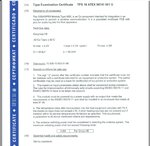hm_fa_da
Full Member level 5

Hi,
I am going to use Quectel M95 GSM Module in an IS circuit for Zone 1.
According to Type examination certificate of M95:

As you see in the file, it's mentioned: Ui(max)=<4.2V, Ii(max)=2.1A, Pi(max) =<2W.
As i know, i have to make a power supply which has limited parameters compatible with M95 Module values, means:
Uo(max) <4.2V, Isc(max)<2.1A, Po(max) <2W to keep the M95 Module in intrinsically safe state.
But current limiting is not possible by simply using a resistor, because in that case i need to use a 2ohm resistor which stops module working fine in normal conditions (because of high voltage drops result of pulse current sinking of GSM module - up to 1.6A )
So the only solution is using Active current and Active power limiters !
Is this right ?
and because of using device in Zone 1, i have to use 2 series of each Current and power limiters ... which seems little strange !
Note that I just need the maximum antenna radiation of the module to stay lower than 3.5W, Because i want to use whole GSM circuit and module in an encapsulation according to ATEX, but the antenna will be out of encapsulation, so antenna radiation should be still limited down to <3.5W to be compatible for gas group IIB.
The complete ATEX Type examination certificate PDF of M95 is Attached.
I am going to use Quectel M95 GSM Module in an IS circuit for Zone 1.
According to Type examination certificate of M95:

As you see in the file, it's mentioned: Ui(max)=<4.2V, Ii(max)=2.1A, Pi(max) =<2W.
As i know, i have to make a power supply which has limited parameters compatible with M95 Module values, means:
Uo(max) <4.2V, Isc(max)<2.1A, Po(max) <2W to keep the M95 Module in intrinsically safe state.
But current limiting is not possible by simply using a resistor, because in that case i need to use a 2ohm resistor which stops module working fine in normal conditions (because of high voltage drops result of pulse current sinking of GSM module - up to 1.6A )
So the only solution is using Active current and Active power limiters !
Is this right ?
and because of using device in Zone 1, i have to use 2 series of each Current and power limiters ... which seems little strange !
Note that I just need the maximum antenna radiation of the module to stay lower than 3.5W, Because i want to use whole GSM circuit and module in an encapsulation according to ATEX, but the antenna will be out of encapsulation, so antenna radiation should be still limited down to <3.5W to be compatible for gas group IIB.
The complete ATEX Type examination certificate PDF of M95 is Attached.



